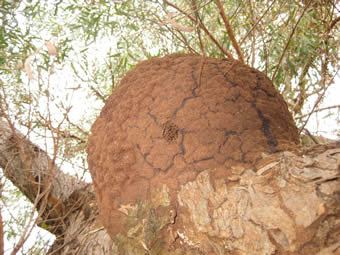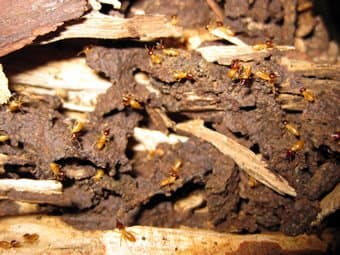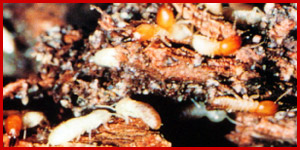
Termites, Cockroaches And Spiders can run but they can't hide from Micropest Pest Control Sydney.



















|
Termites Sydney Australia.The Termite Specialists.
OPEN 7 AM - 10 PM 7 DAYS.To understand Sydney termites (white ants), prevention and control, it's best to determine what termite species they are and how they breed, feed and live. There are three problematic species in Sydney, the worst being Coptotermes acinaciformis closely followed by Schedorhinotermes and the least damaging Nasutitermes. If you think you have found any of these species of termites in your building, a termite inspection should be conducted expediently, followed by an appropriate termite control treatment. Termites (White Ants) are prehistoric and have existed for millions of years, and believe it or not, the closest insect they are related to are cockroaches. They belong to the insect order of isoptera meaning "iso", meaning equal, and "ptera" meaning wings, referring to the reproductive termite known as alates or flying termites with similar wings and venation of the four wings. Termites live in a humid, protected subterranean or enclosed environment of dirt and partially digested wood or cellulose. Some species live in a nest with a hardened external shell above the ground or up a tree ( Nasutitermes ). Still, Sydney's most destructive termite species have nests below ground level in the root ball of a tree or under a cement slab ( Coptotermes and Schedorhinotermes). The nest's interior is maintained between 25 and 30 degrees Celsius with high humidity. Bright light or open-air will cause the termites to die of dehydration, so most termites in a colony live in constant darkness, except for swarming termites that fly outside to establish new colonies. Termites (White Ants) are social insects, and there are multiple castes within the colony, alates, Queen, King, nursery, soldiers and workers. Termites live in a central colony and radiate from approximately 100 metres in search of food (timber or cellulose material). The worker termite particularly digest the cellulose materials before returning to the nest to feed the colony. This is what causes damage to our buildings and bank accounts, as many Sydney-siders will attest, and unfortunately, it can happen in a matter of months. That is why a termite inspection in Sydney is recommended at least once a year. Sydney termites (white ants) are so unpredictable and destructive because they are blind and can't smell. Foraging termites blunder upon their food source and can't distinguish between a building or trees. Alate termites swarm three or four times a year, usually in summer. Each time they swarm, they start up several new nests, usually not far away from the mother termite nest. So that's twenty-eight new termite colonies started every year from one nest. It takes approximately seven years for these immature termite nests to become commercially destructive. For these immature nests to survive, all they need is a constant food and moisture source. The most interesting fact about termites is that they feed each other through trophallaxis, meaning they get their nutrition from grooming each other (licking the sweat off each others back). Castes Within the Termite ColonyAlates Termites swarm between November and January in Sydney. On a warm, humid evening, the colony releases thousands of winged male and female termites (white ants), known as alates. A small number survive the flight, drop their two pairs of distinctive, equal-sized wings, pair off, mate, and, if they can, find a suitable location and start a new colony. A suitable location for nesting termites is generally a damp area with a constant water source. They like to nest in the root balls of trees, behind retaining walls and underneath houses with drainage or plumbing problems. What Are Flying Termites?A short video explaining the very important roll of flying termites within the termite colony.The difference between flying ants and flying termites. Queen As the other termites (white ants) castes take over the running of the colony, the Queen of most species of termites becomes physogastric. Her abdomen distends to many times its original size, and she becomes an egg-laying machine, laying up to 1000 eggs a day. She is confined to her royal chamber, tended and fed by the workers and regularly fertilised by the king. There is only one Queen in a termite nest, and it is generally situated in the centre of the nest and is very hard for predators to get to. Nursery The termite eggs are removed from the royal chamber and transferred to a nursery by the workers. Here the broo (the eggs and nymphs) develops into the other castes that the colony requires for development and survival; workers, soldiers and reproductive s. Worker Termites Worker termites are blind and sterile. The workers carry out the work of the colony and are responsible for feeding the termite colony. They make up the bulk of the population in a colony. They are typically 3 to 4 mm long, have a soft body with no armour, translucent colour, lack wings, are incapable of reproduction, and are blind. They work in the nest twenty-four hours a day, foraging for food, building, repairing and maintaining the nest structure and tunnel systems that lead to the food. Workers are the only termites that can digest cellulose, utilising protozoa in their digestive systems to feed the other castes of termites in the termite nest through trophallaxis. The workers in a colony will forage randomly in their search for food sources and like to follow moisture trails along the edge of solid objects, accompanied by soldier termites. Soldier TermitesSoldier termites protect the nest from predators such as ants. Soldiers have an armoured heads with strong pincers used to crush attackers. Some can inject a latex substance that will trap enemies. Termites Price ListThere are many complexities and variables involved in giving an accurate quote for the treatment of termites. To get an accurate quote, a termite inspection is essential. However, I have being in the industry for over thirty-five years, and if you ring me, I can give you a ballpark figure if you name the suburb you live in, the size of the house and the type of construction. What precautions can you take to reduce the chances of termites eating your house?To answer this question firstly, it is very important to understand that termite’s living conditions are generally dark, humid, wet and with no airflow. 1) Remove all building materials and stored materials in contact with the ground from the sub-floor of the house. Every third house I go to the client uses their sub-floor as a rubbish dump or for storage of old furniture and cardboard boxes. When renovations are carried out on a house, it is cheaper for builders to leave all their rubbish under the house rather than removing it, out of sight and out of mind. The most common area for termites to start in a house is under suspended cement slabs because the builders have neglected to remove the timber formwork. 2) A lot of houses I conduct termite inspections on have bad subfloor ventilation. Instead of putting air-conditioning ducting in the subfloor, put it in the roof, and if you have to tie it up to the floor joists. Do not store anything in the sub-floor. Replace all terracotta air vents with alleta bronze mesh air vents or a ducted extraction fan. They increase airflow by one hundred percent. All termites do not like airflow. Make sure you get a termite inspection at least once a year. This will hopefully catch the termites early, which will reduce the amount of damage they cause. Any time of year is appropriate for a termite inspection, especially if you have not had one for a while. The most important precaution to take to reduce the chances of termites in your house and or building is to make sure all the drainage and plumbing is in tiptop condition around and under the house. The most common areas that termites are found in a house are the wet areas, especially the bathrooms and laundries. I would have to say leaking showers are the single most common reason for termites in houses in Sydney. The second would have to be blocked storm-water and sewage drains which flow under houses, broken water pipes, overflows from the air-conditioner and the hot water systems. Now how do we rectify these moisture issues?1) Once a year clean out all the internal plumbing with Draino. 2) Every year, get a plumber to check and clean out all the storm-water drains with a jet blaster. 3) Get a termite inspection every year by Micropest Pest control Sydney. We will check for leaking showers, broken drains and water pipes. 4) Clean out your storm-water roof gutters every four months. 5) Attach a hose from the air-conditioner over flow pipe and directed to a drain or away from the house. 6) Attach a water hose to the hot water overflow pipe and direct it away from the house or into a drain. 7) Improve your sub-floor ventilation. Termites. Questions and answers.Comments: Hi, I have some wooden Aboriginal Art from Maningrida in Arnhem land, and small holes are appearing in it. This art is in the form of 5 large, 1-2 meters high, thin sticks. I am worried there is bora in them that need to be treated. A gallery down here suggested they had the same problem, and it wasn't termites. Could you come and inspect? REPLY: Small round holes are defiantly Bora and not termites, There are a lot (thousands) of these flying yellow ants raining down on the desk in my study, which is under the main (concrete) steps and pathway to the front door of the house. They did this about 6 months ago, then stopped. Just started up again. REPLY: These flying yellow ants that appear just before an impending storm are alate termites or flying termites. The kings and queens of a termite nest. Strongly recommend a termite inspection. Mission Statement?Termites Sydney company Micropest Pest Control Sydney will endeavour to assist you in the best and most helpful way and will always treat the customer with respect honestly and ethically. Our Locations WahroongaAddress: 24/24-36 Pacific Highway, Wahroonga N.S.W 2076 Phone:1300 243 377 Hours: Open 7 days, 7 am–10 pm We provide the same day emergency services for the Upper North Shore suburbs of Wahroonga, Pymble, Hornsby, Turramurra, Westleigh and Thornleigh. BerowraAddress:111 Yallambee Road Berowra, Sydney N.S.W 2081. Phone:(02) 9489 0013 Hours: Open 7 days, 7 am–10 pm We provide the same day emergency services for Berowra, Galston, Arcadia, Brooklyn, Mt White, Mt Colah and Asquith. ArtarmonAddress: 43 Whiting St, Artarmon NSW 2064 Phone:1300 884 166 Hours: Open 7 days, 7 am–10 pm We provide the same day emergency services for the Lower North Shore suburbs of Artarmon, Chatswood, Lane Cove, Roseville, Lindfield, Killara, North Sydney, Neutral Bay, North Bridge and Castlecrag. |

|
|||||||